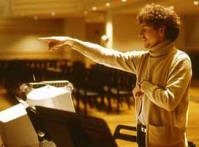
Composers
- bio - worksHe bases his creativity on a broad background of musical skills including: composition, piano, conducting, ancient music, organ, harpsichord, new media and Japanese instruments. At the age of 17 he was soloist in Mozart's Piano Concertos and in the 20-ies started to inventively arrange and conduct vocal and instrumental pieces ranging from early to contemporary music.
He graduated from the Conservatories of Bologna and Milan, studying with Alessandro Solbiati, and achieved the post-graduate composition course at the National Academy Santa Cecilia of Rome.
He attended classes of Boulez, Ferneyhough, Ligeti, Manoury, Murail, Risset, Stroppa and Yuasa, additionally to ancient music courses with Jordi Savall. During the Centre Acanthes 1996, Yvonne Loriod Messiaen praised him as a very talented composer.
Carlo Forlivesi is author of about twenty compositions. His output features both electronic and acoustic scores from solo to orchestra (see the Work List).
In 1997 he was selected for the IRCAM's year-long program. The following year he composed The fairy's book covered in dew for piano and electronics, premiered by the pianist Jean-Marie Cottet at the IRCAM's Espace de Projection (Centre Georges Pompidou, Paris).
From 1999 he was guest artist at DIEM (Danish Institute of Electroacoustic Music), where he composed Requiem, a piece for 8-channel tape performed during the International Music Festival Da Bach a Bartok 2000.
Successively, the Danish Government granted him a Composer-in-Research fellowship to work at DIEM about "Gestural controllers and interactive computer music systems for dance"; during this time he outlined the computer settings that will be used later in his dance opera Kaya.
In 2000 his first piece for orchestra Mutter Morte was premiered at the Tokyo Opera City Concert Hall by the Tokyo Metropolitan Symphony Orchestra. In the same year his piano solo piece La pointe à la droite du coeur was performed at the Tokyo Opera City Recital Hall by the pianist Satoshi Inagaki.
Afterwards, his aesthetic intensely related with Japanese traditional arts, exploring the field of sensitivity. He deepened his understanding by collaborations with eminent Nihon-buyo and Noh artists such as Hideka Fujima and Atsuko Nagamune. Furthermore, Carlo Forlivesi has learnt Japanese traditional instrumental techniques in Kyoto and Tokyo, enabling him to compose new music for Japanese traditional instruments.
In 2001 he was selected Artist-in-Residence by the Akiyoshidai International Art Village, where Forlivesi's eclectic outlook flourished in his most challenging work-in-progress Kaya, a 3-act piece for Noh and modern dancers, acoustic instruments and interactive computer system; the first part of it was premiered under the direction of the composer and broadcasted.
In 2002 Three lyrics of Kyoka Izumi for mezzo-soprano, tenor and orchestra, was first performed at the Yakult Hall in Amsterdam during the International Gaudeamus Music Week by Anna-Maria Dur, Bernard Loonen and the Holland Symfonia under the direction of Peter Hirsch.
In 2003 Japanese Window - Sesshu's Landscape 1495, a performing piece matching electronics and Japanese traditional dance, was awarded by the Yamaha Music Foundation for its distinctive quality and originality, premiered by the Nihon-Buyo dancer Sayuri Unou, then issued on numerous international magazines, broadcasted and staged several times under Yamaha sponsorship. This work has been enthusiastically welcomed by the audience because in spite of being new and advanced, the computer elaboration of Japanese traditional instruments such as Koto and Shakuhachi generates an unexpected and rare match of antique and modern, enchanting the listener with a delightful harmony accompanied by the choreographic grace of the Nihon-buyo style.
His latest work, Myosotis Triptych, a composition for choir, boy voice, 2 trumpets in echo, 3 trombones, tuba and 2 percussionists, was requested at first by the Emilia-Romagna Festival for the European project "The Sounds of Spirit", a large-scale event powered by the EU Culture, and then independently selected also for the International Gaudeamus Music Week 2003. Thus, the piece, setting lyrics from the Book of Psalms, Dante Alighieri and Pavel Florenskij, is going to be performed all around Europe alternately by the Ensemble Vocale Laboratorio Ottantasette conducted by Paola Urbinati and the Koor Nieuwe Muziek and the Gaudeamus Ensemble conducted by René Nieuwint.
Up to now, Carlo Forlivesi has been awarded several prizes and grants such as the Bologna Academy Composition Prize (1996), the Milan Conservatory Commission (1997), the Movin'Up Art Programme (1999 and 2000), in addition to scholarships from the Danish Government and the Japanese Government.
International distinctions include being finalist at the Toru Takemitsu Composition Award 2000, winning the 2001 DTKV Landesverband Sachsen 3rd prize, and selection for the Gaudeamus Music Week 2002 and 2003.
His music has been performed in Italy, France, Germany, Holland, Slovenia, Yugoslavia, Japan and China, appearing in international festivals and halls such as International Gaudeamus Music Week, Tokyo Opera City, Akiyoshidai International Art Village Concert Hall, Shanghai Washi Exposition, IRCAM, DTKV Leipzig, Incontri Musicali, Da Back a Bartok, L'officina Musicale, Il Circolo della Musica, Emilia-Romagna Festival, Ljubljana Festival, Northern Cultural Forum, etc.
New performances are scheduled in Canada, Japan, Italy and Germany.
He is regularly invited to give lectures at the international music season "Il Circolo della Musica Imola" of Imola.
At present, as a Composer-in-Research by the Japanese Government, Carlo Forlivesi studies traditional instruments at the Tokyo Music College and is working on new pieces for the cellist Benjamin Carat and biwa player Yukio Tanaka.

